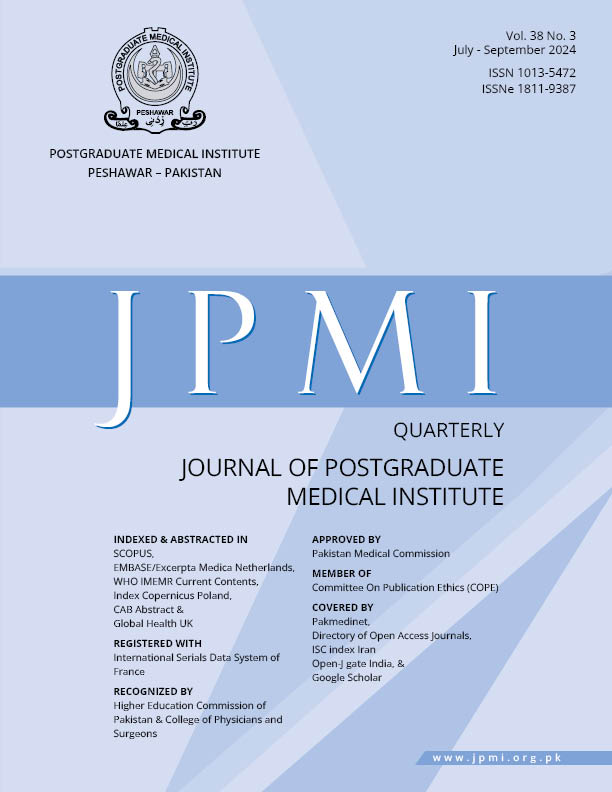Transradial Angiography with Dedicated Catheter: A Tertiary Care Center Experience
Main Article Content
Abstract
Objective: To demonstrate the safety and feasibility of tiger catheter for trans-radialcoronary angiography.
Methodology: It was a retrospective observational study conducted at the Peshawar Institute of Cardiology. A total of 2728 patients were included over a period of 1 year, from Apr 01, 2021, to Mar 31, 2022, who underwent radial angiography with a tiger catheter. All data was collected through the hospital database. Angiography clips were analyzed by senior consultant cardiologists for the occurrence of any complications.
Results: Among 2728 patients, 60.63% of patients were males, and 39,36% were females. The mean fluoroscopy time was 0.85±0.36 minutes. The mean contrast volume used was 33.33±10.19 ml. The rate of any major complication was extremely low. Radial artery spasm was the most common complication and occurred in 3.9% of cases. Coronary artery ostial dissection occurred in only 4 cases, and all were successfully stented. Switching over to Judkins left (1.94%) and Judkins right (1.76%) catheter in cases of difficult engagement was also very low.
Conclusion: Our study has demonstrated that radial angiography performed with a Tiger catheter is associated with low contrast volume and fluoroscopy time and an extremely low rate of any major complication.
Article Details
Work published in JPMI is licensed under a
Creative Commons Attribution-NonCommercial 2.0 Generic License.
Authors are permitted and encouraged to post their work online (e.g., in institutional repositories or on their website) prior to and during the submission process, as it can lead to productive exchanges, as well as earlier and greater citation of published work.
References
Kandaswamy E, Zuo L. Recent advances in treatment of coronary artery disease: role of science and technology. Int J Mol Sci. 2018;19(2):424. DOI: 10.3390/ijms19020424.
Bhat FA, Changal KH, Raina H, Tramboo NA, Rather HA. Transradial versus transfemoral approach for coronary angiography and angioplasty–a prospective, randomized comparison. BMC Cardiovasc Disord.. 2017;17:1-7. DOI: 10.1186/s12872-016-0457-2.
Golla MS, Brown KN, Gupta N. Percutaneous Transluminal Coronary Arteriography. StatPearls: StatPearls Publishing; 2023.
Gerber Y, Gibbons RJ, Weston SA, Fabbri M, Herrmann J, Manemann SM, et al. Coronary disease surveillance in the community: angiography and revascularization. J Am Heart Assoc. 2020;9(7):e015231.DOI: 10.1161/JAHA.119.015231.
Aldoori JS, Mohammed AI. Transradial approach for coronary angiography and percutaneous coronary intervention: personal experience. Egypt Heart J. 2019;71(1):10. DOI: 10.1186/s43044-019-0006-2.
Mann T. The radial approach for coronary angiography and stenting. BMJ Publishing Group Ltd and British Cardiovascular Society; 1999. p. 411-2.
Ando G, Capodanno D. Radial access reduces mortality in patients with acute coronary syndromes: results from an updated trial sequential analysis of randomized trials. JACC Cardiovasc Interv. 2016;9(7):660-70.
Valgimigli M, Gagnor A, Calabro P, Frigoli E, Leonardi S, Zaro T, et al. Radial versus femoral access in patients with acute coronary syndromes undergoing invasive management: a randomised multicentre trial. Lancet. 2015;385(9986):2465-76.DOI: 10.1016/S0140-6736(15)60292-6.
Vorpahl M, Koehler T, Foerst J, Panagiotopoulos S, Schleiting H, Koss K, et al. Single center retrospective analysis of conventional and radial TIG catheters for transradial diagnostic coronary angiography. Cardiol Res Pract. 2015;2015. DOI:10.1155/2015/862156.
Langer C, Riehle J, Wuttig H, Durrwald S, Lange H, Samol A, et al. Efficacy of a one-catheter concept for transradial coronary angiography. PLoS One. 2018;13(1):e0189899. DOI: 10.1371/journal.pone.0189899.
Rigattieri S, Valsecchi O, Sciahbasi A, Tomassini F, Limbruno U, Marchese A, et al. Current practice of transradial approach for coronary procedures: A survey by the Italian Society of Interventional Cardiology (SICI-GISE) and the Italian Radial Club. Cardiovasc Revasc Med. 2017;18(3):154-9. DOI: 10.1016/j.carrev.2017.01.005.
Sciahbasi A, Frigoli E, Sarandrea A, Rothenbuhler M, Calabro P, Lupi A, et al. Radiation exposure and vascular access in acute coronary syndromes: the RAD-Matrix trial. J Am Coll Cardiol. 2017;69(20):2530-7.
Chen O, Goel S, Acholonu M, Kulbak G, Verma S, Travlos E, et al. Comparison of Standard Catheters Versus Radial Artery–Specific Catheter in Patients Who Underwent Coronary Angiography Through Transradial Access. Am J Cardiol. 2016;118(3):357-61.DOI: 10.1016/j.amjcard.2016.05.010.
Esteves V, Mattos LA, Ferreira E, Albuquerque DC. TIger II vs Judkins catheters for transradial coronary angiography (TIJUCA study): a randomized controlled trial of radiation exposure. J Invasive Cardiol. 2021;33(3):E200-5.
Case BC, Yerasi C, Forrestal BJ, Chezar-Azerrad C, Khan JM, Khalid N, et al. Right transradial coronary angiography in the setting of tortuous brachiocephalic/thoracic aorta (“elephant head”): Impact on fluoroscopy time and contrast use. Catheterization and Cardiovascular Interventions. 2022;99(2):418-23. DOI: 10.1002/ccd.29470.


